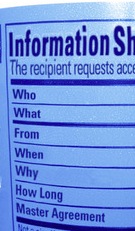![]() We lie every time we “accept” terms that we haven’t read — a pro forma behavior that is all but required by the calf-cow model of the Web that’s prevailed since 1995. We need to change that. And so we are.
We lie every time we “accept” terms that we haven’t read — a pro forma behavior that is all but required by the calf-cow model of the Web that’s prevailed since 1995. We need to change that. And so we are.
StandardLabel.org is working on “A clear, consistent way for websites to say what they do with the data they share, before we share it.” While its recent Kickstarter campaign came up a bit short, the work continues. Here is one (prototypical) way that label might look:
(The actual image I wanted there was this one, but heard it wasn’t showing up in all browsers, so I went with the one above.)
The StandardLabel folks also have a survey, which I recommend taking.
CommonTerms intends “to solve the problem of non-accessible online legal texts in a way similar to how Creative Commons made different copyright licenses accessible,” adding, “We thought that by analyzing existing agreements, we could identify the most common terms, and then create icons to symbolize them.” Background:
The CommonTerms project is coordinated by Metamatrix AB andsponsored by Internetfonden.se…
The project is a result of a session on “sustainable web development” by Pär Lannerö and Thomas Bjelkeman at the Sweden Social Web Camp, in August 2010.
Their prototype, focused on icons, stars Pär and looks like this:
Par and Lars-Erik Jakobsson (icon), Gregg Bernstein, Carl Törnquist, Hanna Arkestål, Max Walter, Mattias Aspelund, Anders Carlman have since added BiggestLie.com, source of the image at the top of this post, plus this one here, which I just earned:
 The idea is to start getting real about what we’re all doing and not doing.
The idea is to start getting real about what we’re all doing and not doing.
What we’re doing is lying: i.e. agreeing not only to what we don’t read, but to the rotted status quo of which one-sided non-agreements are a part. What we’ve not been doing for most of the last 17 years is solving the problem.
But, thanks to the work above (plus whatever I’ve missed), we are doing some things. So are PDEC.cc and companies like Personal. Other work is happening with personal clouds. (PDEC is on that case too.) Aza Raskin‘s Privacy Icons are an effort in this same direction. (CommonTerms has a longer list.)
Still, looks to me like most of the work being done so far is on the cow side of the calf-cow relationship. On our side, we need to stop being calves, for real. That is, we need to have full agency in the original sense of the word: power to cause intended effects on our own.
For that we will need machine- and user-readable ways to express own terms, preferences and policies, so they can be read by sites (the cows) and matched up. That’s the idea behind EmanciTerm, described in How about using the ‘No Track’ button we already have? and in The Intention Economy. There I explain,
With full agency, however, an individual can say, in the first person voice, “I own my data, I control who gets access to it, and I specify what I wish to happen under what conditions.” In the latter category, those wishes might include:
- Don’t track my activities outside of this site.
- Don’t put cookies in my browser for anything other than helping us remember each other and where we were.
- Make data collected about me available in a standard, open format.
- Please meet my fourth-party agent, Personal.com (or whomever).
These are EmanciTerms, and there will be corresponding ones on the vendor’s side. Once they are made simple and straightforward enough, they should become normative to the point where they serve as de facto stan- dards, in practice.
Since the terms should be agreeable and can be expressed in text that code can parse, the process of arriving at agreements can be automated.
For example, when using a public wi-fi access point, a person’s EmanciTerms might say, “I will not knowingly hog this shared resource, for example, by watching high-def video on it,” or “I will not engage in illegal activities here.” If the provider of the access point has a VRM-ready service that is willing to deal with the user on his or her own EmanciTerms as well as those of the provider, it should be possible to automate the formalities and let the user bypass the usual “read and accept our agreement” ritual.
Not everything we express in the proposed ceremony here has to be one side of a binding agreement. If we express these terms as preferences or policies they can still be heard, even if they’re not agreed to. Being heard is one idea behind BiggestLie. But the cows can’t fix this on their own. We need to work both sides.
The only problem with all this is that our work is scattered. Let’s get it together.


